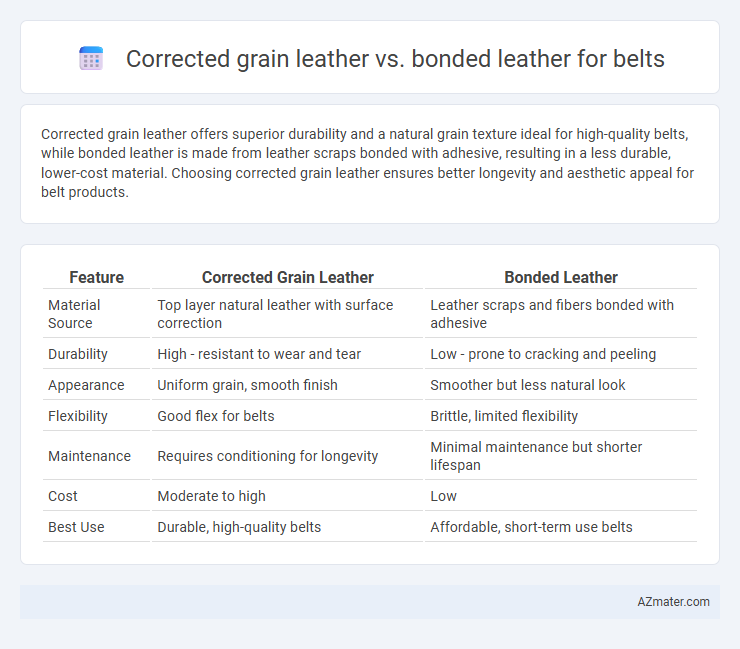Corrected grain leather offers superior durability and a natural grain texture ideal for high-quality belts, while bonded leather is made from leather scraps bonded with adhesive, resulting in a less durable, lower-cost material. Choosing corrected grain leather ensures better longevity and aesthetic appeal for belt products.
Table of Comparison
| Feature | Corrected Grain Leather | Bonded Leather |
|---|---|---|
| Material Source | Top layer natural leather with surface correction | Leather scraps and fibers bonded with adhesive |
| Durability | High - resistant to wear and tear | Low - prone to cracking and peeling |
| Appearance | Uniform grain, smooth finish | Smoother but less natural look |
| Flexibility | Good flex for belts | Brittle, limited flexibility |
| Maintenance | Requires conditioning for longevity | Minimal maintenance but shorter lifespan |
| Cost | Moderate to high | Low |
| Best Use | Durable, high-quality belts | Affordable, short-term use belts |
Introduction: Understanding Corrected Grain and Bonded Leather
Corrected grain leather is made from genuine leather with a sanded and coated surface to remove imperfections, offering durability and a consistent appearance ideal for belts. Bonded leather consists of leather scraps and fibers bonded together with adhesives, providing an affordable but less durable alternative that often peels over time. Choosing between corrected grain and bonded leather depends on balancing budget with longevity and quality in belt materials.
What is Corrected Grain Leather?
Corrected grain leather is genuine leather that undergoes a surface treatment to remove imperfections, including buffing and embossing with a grain pattern for a uniform appearance. This type of leather retains durability and strength, making it suitable for belts that require both style and longevity. In contrast, bonded leather is made from shredded leather fibers mixed with polyurethane or latex, resulting in a less durable and lower-quality material often used for budget-friendly belts.
What is Bonded Leather?
Bonded leather is made by combining shredded leather fibers with a polyurethane or latex binder, then applying the mixture onto a fabric backing, resulting in a material that mimics genuine leather but contains a low percentage of actual leather content. Corrected grain leather, by contrast, is a top-grain leather that has been sanded and embossed to remove imperfections, maintaining a higher quality and durability than bonded leather. For belts, bonded leather may offer affordability and appearance but lacks the strength and longevity of corrected grain leather.
Durability Comparison: Corrected Grain vs Bonded Leather
Corrected grain leather offers superior durability for belts due to its intact leather fibers and protective top coating, resisting wear and stretching over time better than bonded leather. Bonded leather, composed of shredded leather scraps bonded with polyurethane or latex, tends to peel and crack more quickly under frequent use and stress. Choosing corrected grain leather ensures longer-lasting belts that maintain structural integrity and aesthetic appeal through extensive wear.
Appearance and Texture Differences
Corrected grain leather for belts features a smoother, more uniform appearance due to its buffed surface with applied pigment, offering a refined texture that mimics natural leather closely. Bonded leather, made from leather scraps bonded with polyurethane or latex, typically shows a less consistent surface with a synthetic feel and often contains visible imperfections or uneven texture. The durability and natural grain detail of corrected grain leather provide a higher-end look and touch compared to the flatter, artificial texture of bonded leather.
Comfort and Flexibility in Belts
Corrected grain leather offers superior comfort and flexibility for belts due to its natural grain surface that allows for better breathability and a soft, pliable texture that adapts well to wrist movement. Bonded leather, made from shredded leather fibers bonded with adhesives, tends to be stiffer and less breathable, which can reduce overall comfort and restrict flexibility during extended wear. Choosing corrected grain leather ensures a durable yet comfortable belt that maintains its shape and provides greater ease of movement.
Price Differences: Which is More Cost-Effective?
Corrected grain leather belts typically cost more than bonded leather due to higher-quality material and durability, making them a better long-term investment despite a higher initial price. Bonded leather belts, composed of leather scraps bonded with polyurethane or latex, are more affordable but sacrifice longevity and appearance over time. For budget-conscious buyers seeking cost-effectiveness, bonded leather offers a lower upfront price, while corrected grain leather presents greater value through extended wear and superior finish.
Environmental Impact and Sustainability
Corrected grain leather involves sanding and buffing the surface to remove imperfections, which generates less waste compared to bonded leather made from shredded leather scraps mixed with synthetic binders. Bonded leather typically contains polyurethane or latex binders, resulting in lower durability and recyclability, negatively impacting sustainability. Environmental impact is further heightened by the chemical adhesives and synthetic materials in bonded leather, whereas corrected grain leather, derived from higher-quality hides, offers a more eco-conscious choice for belt production.
Ideal Uses: Who Should Choose Which Leather?
Corrected grain leather, characterized by its durability and smooth finish after surface treatment, is ideal for belt users seeking long-lasting quality and a refined appearance, such as professionals or those needing daily wear. Bonded leather, made from leather scraps bonded with polyurethane, suits budget-conscious buyers wanting the look of leather with less investment, perfect for occasional or fashion-forward use. Choosing between these depends on prioritizing either longevity and premium feel (corrected grain) or affordability and style variety (bonded leather).
Conclusion: Which Leather is Best for Belts?
Corrected grain leather offers superior durability, natural texture, and a longer lifespan compared to bonded leather, which is made from leather scraps mixed with adhesives and synthetic materials. For belts, corrected grain leather provides better strength, flexibility, and breathability, ensuring comfort and style over time. Choosing corrected grain leather is ideal for those seeking a high-quality, long-lasting belt with authentic leather characteristics.

Infographic: Corrected grain leather vs Bonded leather for Belt
 azmater.com
azmater.com